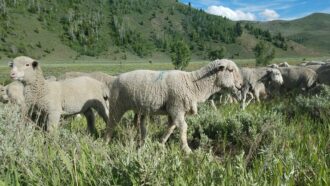Wildfires in the West are inevitable and part of a natural, necessary ecological cycle, but invasive grasses like cheatgrass can make fires burn hotter, spread farther and cause more destruction.
So, across the West, researchers, range managers, cattle ranchers and others are looking for ways to economically control cheatgrass and other invasive grasses on millions of acres of rangeland.
Add sheep herders to that list.
A multi-disciplinary team that includes university researchers, U.S. Forest Service experts and several partnering sheep producers in Central Idaho recently received a $350,000, three-year grant from the Western Sustainable Agriculture Research and Education program to see if sheep can be a precision tool to target cheatgrass.
“The research team and our partners are all really interested in using sheep,” explained lead researcher Kelly Hopping, an assistant professor of human-environment systems at Boise State University. “There have been cheatgrass targeted grazing studies using cattle but not many that have looked at using sheep.”
There is a good reason for researching sheep. First, there are more than two million sheep being raised in the West, and they can reach places cattle don’t like to graze. In the research area in Idaho, the team is looking at grazing allotments high in the Sawtooth National Forest.
“They are almost all between 7,000 to 8,000 feet elevation and pretty steep,” Hopping said. “A lot of these allotments burned in 2013 and a lot of cheatgrass came in after that.”
The research will graze sheep on 32 plots, testing an earlier-than-normal spring grazing, a later-than-normal fall grazing and an early-spring, late-fall grazing against the traditional summer “once-over” grazing. Because cheatgrass germinates earlier than most native grasses and starts growing again later into the year (thereby gaining a competitive advantage that helps the species spread), introducing sheep at those times will focus their feeding on cheatgrass.
“One thing we’ll be looking at is changes in vegetation and fuel loads,” Hopping said. “Can this practice create canopy gaps – spaces that will not burn – and create a less continuous load of fuel?”
An interesting element of the research is that it also looks below ground, at soil processes and nitrogen levels. Because if sheep are grazing in cheatgrass-invested areas they’ll also be pooping there.
“Will we find a fertilization effect? Could this practice help cheatgrass perpetuate?” Hopping asked. “That’s one thing we want to know.”
